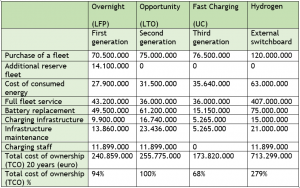An article in Italy’s Autobusweb site reviews green and sustainable e-bus technologies on offer to public transport operators.
Italian public transport companies are facing a wholesale replacement of city buses financed by the NRRP National Recovery and Resilience Plan with a view to supporting fully green and sustainable mobility. The sting is that the NRRP features very tight deadlines and requires rapid and comprehensive decisions on both vehicles and infrastructure.
A number of tests conducted in Italy are yielding reliable data for evaluating the opportunities offered by new local public transport solutions. Alongside battery buses, tests have covered fast charging ultracapacitor buses by consortium SmartBUS-Chariot Motors in La Spezia, Turin, and Rome, and hydrogen buses in Bolzano, Milan, Turin, and Genoa, among others.
We were pleased at the opportunity to summarise things with Prof Riccardo Maggiora from the Polytechnic University of Turin. He has for years researched new technologies and their application in eco transition buses and has produced a valuable succession of papers on traction energy storage, solutions, and strategic factors in bus selection.
Professor Maggiora, what are the green bus technologies in which transport operators may invest today?
Most generally, we may boil them down to four major categories: overnight charging, opportunity charging, fast charging, and hydrogen.
What are the main differences?
Оvernight charging is typical of the first generation of battery electric buses. Autonomy, or range, depends on battery capacity. Often, we find some tougher routes requiring two daily garage charges of between four and six hours each, with attendant service outages. Оvernight charging is not a completely green technology: it requires battery recovery. Batteries do not have a long life; six years at most, and that only if they are always charged correctly. In general, overnight charging buses are very heavy, their energy consumption is high, and they require garage charging infrastructure that is particularly expensive and sensitive. The trend today is to replace this technology with more efficient ones.
Opportunity charging represents the second generation of electric buses. These are battery buses that exceed the autonomy and range limitations of overnight charging, thanks in part to energy replenishment at terminal stops. They generally use a battery with a smaller capacity and greater output. This makes them lighter and more economical. Infrastructure costs are higher compared to overnight charging, requiring both garage charging and down-route boosting. Opportunity charging is also not without its problems, mostly related to battery replacement and recovery. It is not therefore a fully green technology. Its main application is in cities with chaotic and heavy traffic.
Fast charging typifies the third generation of electric buses. The lead concept here is not to oversize storage capacity for whole-day service (as with overnight and partly with opportunity charging) but to optimise bus energy performance to match the toughest route. Here, storage is achieved through nanotechnology ultracapacitors that allow charging in just a few minutes directly at terminal stops.
Ultracapacitors overcome the limitations of electrochemical batteries by offering storage that is more reliable, longer-lived (four times longer than batteries) and lightweight. You can list the advantages of ultracapacitors over batteries like this: significantly longer life; greater reliability, excellent performance retention over time; greater power output; faster charges; and significantly greater brake energy regeneration. These buses do not need time consuming garage charging. They are also better protected from fires. Their main application is high capacity city routes and bus rapid transit (BRT) corridors.
Hydrogen buses are a separate chapter. Their basic concept is the endothermic process. In their case, it is applied to completely green mobility. In the case of hydrogen buses, stored hydrogen powers the fuel cells. These in turn generate electricity, which provides traction. Obviously, all this is fully green only if the hydrogen is derived from renewable energy sources. Bus acquisition costs are also a quarter higher on average than the other types. Maintenance is also more complex and dearer. In short, a clean solution suitable for non-urban environments, but one that comes at a price.
Below is a benchmark of the various solutions, taking into account a fleet of 150 12-meter vehicles covering 60,000km over 20 years of operation:

Typical electric bus daily operation cycles:

Professor Maggiora, given the above what is your most efficient and cost effective green solution for an electric bus?
The answer calls for calculations of both transportation needs and total cost expected over a period: Total Cost of Ownership or TCO. This means that all major cost components must be assessed.
In general and in urban environments, fast charging buses with ultracapacitors appear most cost effective. In non urban environments, opportunity charging appears to a good solution. Hydrogen buses are particularly suitable for long distances. They might become competitive in urban environments once operating and infrastructure costs are cut. Finally, it is important for European Directives and the NRRP fund criteria that the solutions chosen are sustainable, both from an environmental and a business vantage.
Find the article in Italian language on Autobusweb here.





